1988 PONTIAC FIERO wiring
[x] Cancel search: wiringPage 964 of 1825
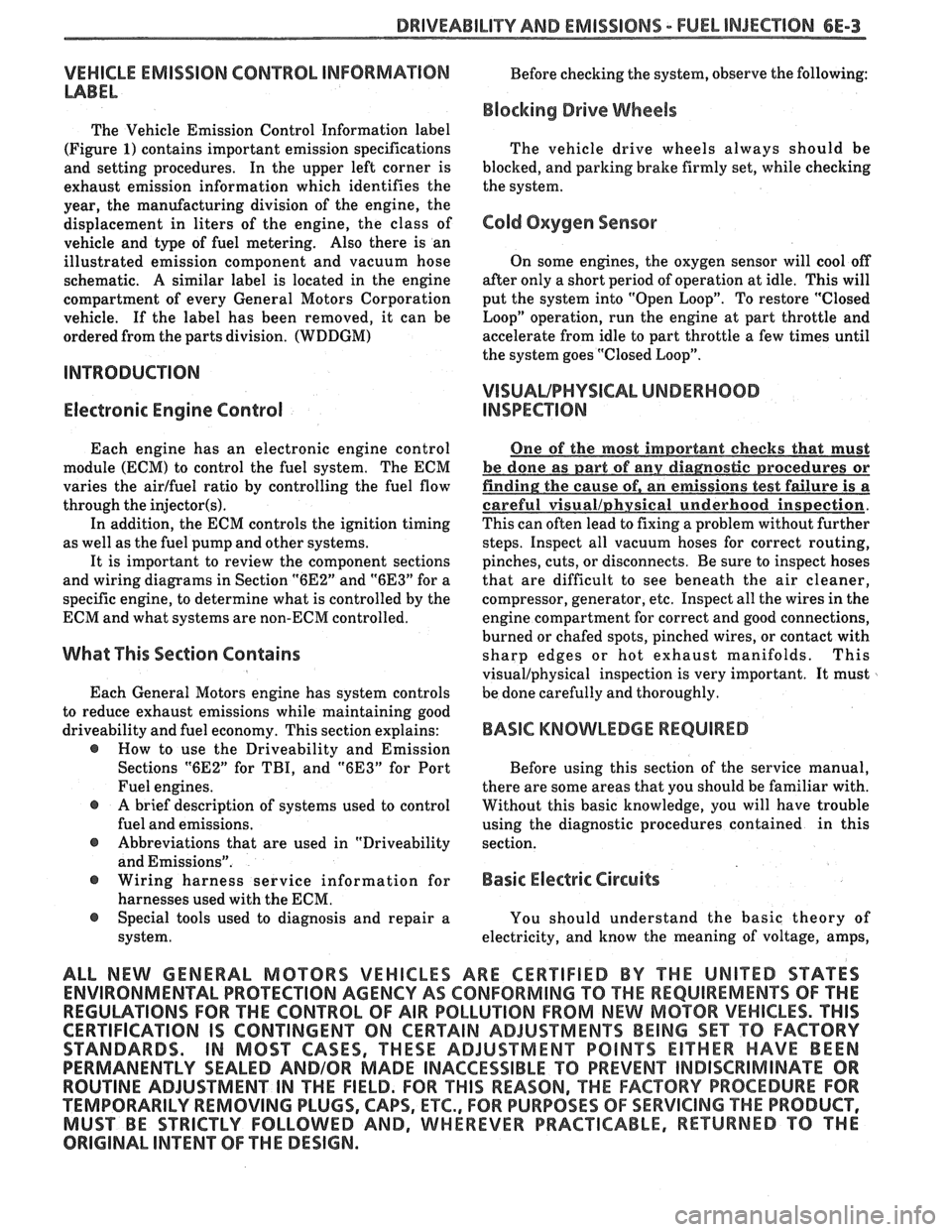
DRIVEABILITY AND EMISSIONS - FUEL INJECTION 6E-3
VEHICLE EMISSION CONTROL INFORMATION
MBEL
The Vehicle Emission Control Information label
(Figure
1) contains important emission specifications
and setting procedures. In the upper left corner is
exhaust emission information which identifies the
year, the manufacturing division of the engine, the
displacement in liters of the engine, the class of
vehicle and type of fuel metering. Also there is an
illustrated emission component and vacuum hose
schematic. A similar label is located in the engine
compartment of every General Motors Corporation
vehicle. If the label has been removed, it can be
ordered from the parts division.
(WDDGM)
INTRODUCTION
Electronic Engine Control
Each engine has an electronic engine control
module
(ECM) to control the fuel system. The ECM
varies the
airlfuel ratio by controlling the fuel flow
through the
injectorb).
In addition, the ECM controls the ignition timing
as well as the fuel pump and other systems.
It is important to review the component sections
and wiring diagrams in Section
"6E2" and "6E3" for a
specific engine, to determine what is controlled by the
ECM and what systems are
non-ECM controlled.
What This Section Contains
Each General Motors engine has system controls
to reduce exhaust emissions while maintaining good
driveability and fuel economy. This section explains:
@ Wow to use the Driveability and Emission
Sections
"6E2" for TBI, and "6E3" for Port
Fuel engines.
A brief description of systems used to control
fuel and emissions.
@ Abbreviations that are used in "Driveability
and Emissions".
@ Wiring harness service information for
harnesses used with the ECM.
@ Special tools used to diagnosis and repair a
system. Before
checking the system, observe the following:
Blocking Drive Wheels
The vehicle drive wheels always should be
blocked, and parking brake firmly set, while checking
the system.
Cold Oxygen Sensor
On some engines, the oxygen sensor will cool off
after only a short period of operation at idle. This will
put the system into "Open Loop". To restore "Closed
Loop" operation, run the engine at part throttle and
accelerate from idle to part throttle a few times until
the system goes "Closed Loop".
VlSUAUPHYSlCAL UNDERHOOD
INSPE6"rON
This can often lead to fixing a problem without further
steps. Inspect all vacuum hoses for correct routing,
pinches, cuts, or disconnects. Be sure to inspect hoses
that are difficult to see beneath the air cleaner,
compressor, generator, etc. Inspect all the wires in the
engine compartment for correct and good connections,
burned or chafed spots, pinched wires, or contact with
sharp edges or hot exhaust manifolds. This
visual/physical inspection is very important. It must ,
be done carefully and thoroughly.
BASIC KNOWLEDGE REQUIRED
Before using this section of the service manual,
there are some areas that you should be familiar with.
Without this basic knowledge, you will have trouble
using the diagnostic procedures contained in this
section.
Basic Electric Circuits
You should understand the basic theory of
electricity, and know the meaning of voltage, amps,
ALL NEW GENERAL MOTORS VEHICLES ARE CERTIFIED BY THE UNITED STATES
ENVIRONMENTAL PROTECTION
AGENCY AS CONFORMING TO THE REQUIREMENTS OF THE
REGULATIONS
FOR THE CONTROL OF AIR POLLUTION FROM NEW MOTOR VEHICLES. THlS
CERTIFICATION IS CONTINGENT OM CERTAIN ADJUSTMENTS BEING SET TO FACTORY
STANDARDS. IN MOST CASES, THESE ADJUSTMENT
POINTS EITHER HAVE BEEN
PERMANENTLY SEALED
AND/OR MADE INACCESSIBLE TO PREVENT INDISCRIMINATE OR
ROUTINE ADJUSTMENT IN THE FIELD. FOR
THlS REASON, "TI- FACTORY PROCEDURE FOR
TEMPORARILY REMOVING PLUGS, CAPS, ETC., FOR PURPOSES OF SERVICING THE PRODUCT,
MUST BE STRICTLY FOLLOWED AND, WHEREVER PRACTICABLE, RETURNED
TO WE
ORIGINAL INTENWF THE DESIGN.
Page 965 of 1825
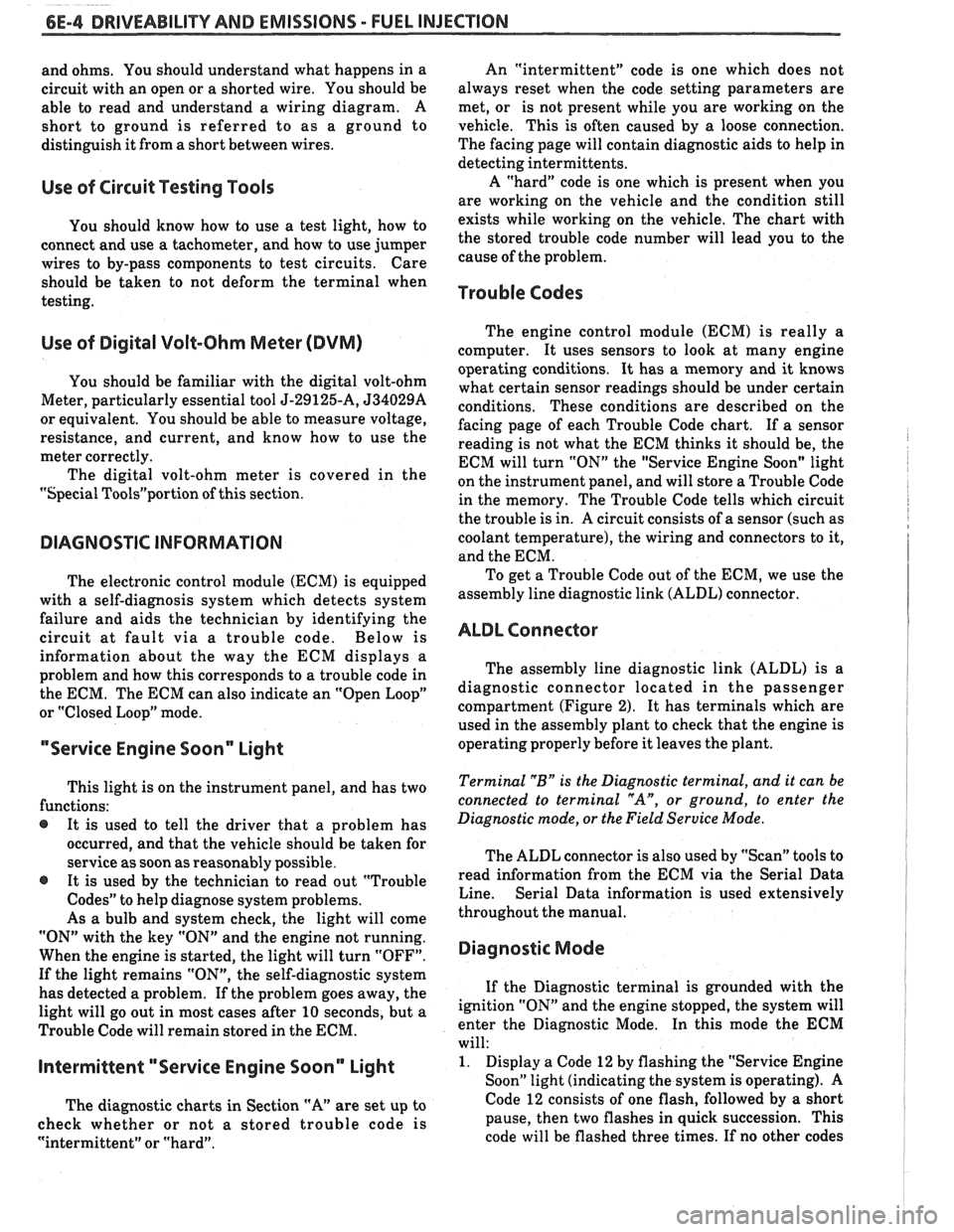
6E-4 DRIVEABILITY AND EMISSIONS - FUEL INJECnON
and ohms. You should understand what happens in a
circuit with an open or a shorted wire. You should be
able to read and understand a wiring diagram. A
short to ground
is referred to as a ground to
distinguish it from a short between wires.
Use of Circuit Testing Tools
You should know how to use a test light, how to
connect and use
a tachometer, and how to use jumper
wires to by-pass components to test circuits. Care
should be taken to not deform the terminal when
testing.
Use of Digital Volt-Ohm Meter (DVM)
You should be familiar with the digital volt-ohm
Meter, particularly essential tool J-29125-A,
J34029A
or equivalent. You should be able to measure voltage,
resistance, and current, and know how to use the
meter correctly.
The digital volt-ohm meter is covered in the
"Special
ToolsJ'portion of this section.
DIAGNOSTIC INFORMATION
The electronic control module (ECM) is equipped
with a self-diagnosis system which detects system
failure and aids the technician by identifying the
circuit at fault via a trouble code. Below is
information about the way the ECM displays a
problem and how this corresponds to a trouble code in
the ECM. The ECM can also indicate an "Open Loop"
or "Closed Loop" mode.
"'Service Engine Soonw Light
This light is on the instrument panel, and has two
functions:
@ It is used to tell the driver that a problem has
occurred, and that the vehicle should be taken for
service as soon as reasonably possible.
@ It is used by the technician to read out "Trouble
CodesJ' to help diagnose system problems.
As a bulb and system check, the light will come
"ON" with the key "ON" and the engine not running.
When the engine is started, the light will turn "OFF".
If the light remains "ONJ', the self-diagnostic system
has detected a problem. If the problem goes away, the
light will go out in most cases after 10 seconds, but a
Trouble Code will remain stored in the ECM.
Intermittent "Service Engine Soon" Light
The diagnostic charts in Section "A" are set up to
check whether or not a stored trouble code is
"intermittent" or "hard". An
"intermittent" code is one which does not
always reset when the code setting parameters are
met, or is not present while you are working on the
vehicle. This is often caused by
a loose connection.
The facing page will contain diagnostic aids to help in
detecting
intermittents.
A "hard" code is one which is present when you
are working on the vehicle and the condition still
exists while working on the vehicle. The chart with
the stored trouble code number will lead you to the
cause of the problem.
Trouble Codes
The engine control module (ECM) is really a
computer. It uses sensors to look at many engine
operating conditions. It has
a memory and it knows
what certain sensor readings should be under certain
conditions. These conditions are described on the
facing page of each Trouble Code chart. If a sensor
reading is not what the ECM thinks it should be, the
ECM will turn "ON" the "Service Engine Soon" light
on the instrument panel, and will store a Trouble Code
in the memory. The Trouble Code tells which circuit
the trouble is in. A circuit consists of a sensor (such as
coolant temperature), the wiring and connectors to it,
and the ECM.
i
To get a Trouble Code out of the ECM, we use the
assembly line diagnostic link (ALDL) connector.
!
ALDL Connector I
I
The assembly line diagnostic link (ALDL) is a
diagnostic connector located in the passenger
compartment (Figure 2). It has terminals which are
used in the assembly plant to check that the engine is
operating properly before it leaves the plant.
Terminal "B" is the Diagnostic terminal, and it can be
connected to terminal
"A", or ground, to enter the
Diagnostic mode, or the Field Service Mode.
The ALDL connector is also used by "ScanJ' tools to
read information from the ECM via the Serial Data
Line. Serial Data information
is used extensively
throughout the manual.
Diagnostic Mode
1
If the Diagnostic terminal is grounded with the
ignition "ON" and the engine stopped, the system will
enter the Diagnostic Mode. In this mode the ECM
will:
1. Display a Code 12 by flashing the "Service Engine
Soon" light (indicating the system is operating). A
Code 12 consists of one flash, followed by a short
pause, then two flashes in quick succession. This
code will be flashed three times. If no other codes
Page 968 of 1825
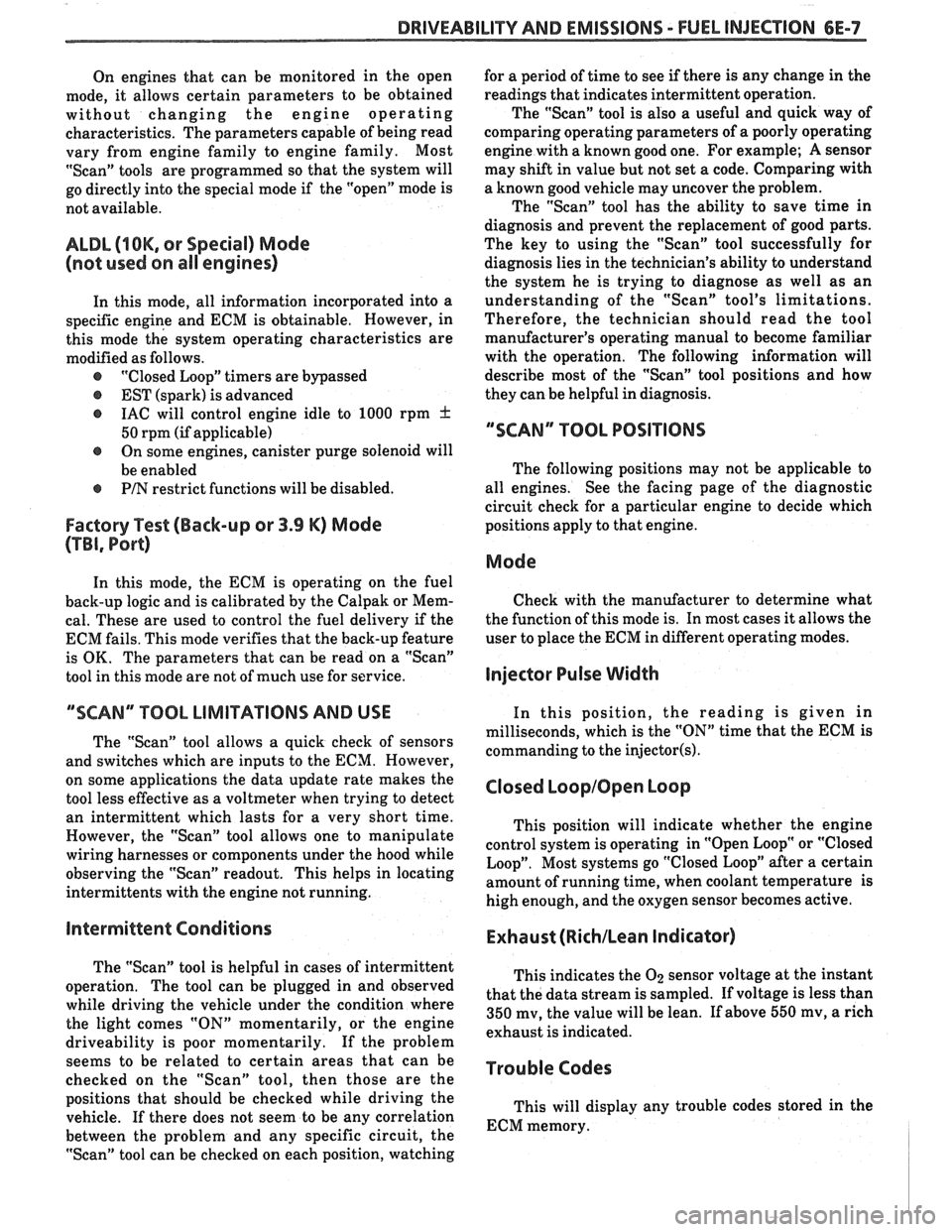
DRIVEABILITY AND EMISSIONS - FUEL INJECTION 6E-7
On engines that can be monitored in the open
mode, it allows certain parameters to be obtained
without changing the engine operating
characteristics. The parameters capable of being read
vary from engine family to engine family. Most
"Scan" tools are programmed so that the system will
go directly into the special mode
if the "open" mode is
not available.
ALDL (7 OK, or Special) Mode
(not used on
all engines)
In this mode, all information incorporated into a
specific
engine and ECM is obtainable. However, in
this mode the system operating characteristics are
modified as follows.
@ "Closed Loop" timers are bypassed
EST (spark) is advanced
@ IAC will control engine idle to 1000 rpm I
50 rpm (if applicable)
@ On some engines, canister purge solenoid will
be enabled
@ P/N restrict functions will be disabled.
Factory Test (Back-up or 3.9 K) Mode
(TBI, Port)
In this mode, the ECM is operating on the fuel
back-up logic and is calibrated by the Calpak or Mem-
cal. These are used to control the fuel delivery
if the
ECM fails. This mode verifies that the back-up feature
is OK. The parameters that can be read on a
"Scan"
tool in this mode are not of much use for service.
"SCAN" TOOL LIMITATIONS AND USE
The "Scan" tool allows a quick check of sensors
and switches which are inputs to the ECM. However,
on some applications the data update rate makes the
tool less effective as a voltmeter when trying to detect
an intermittent which lasts for a very short time.
However, the "Scan" tool allows one to manipulate
wiring harnesses or components under the hood while
observing the "Scan" readout. This helps in locating
intermittents with the engine not running.
intermittent Conditions
for a period of time to see if there is any change in the
readings that indicates intermittent operation.
The "Scan" tool is also a useful and quick way of
comparing operating parameters of a poorly operating
engine with a known good one. For example;
A sensor
may shift in value but not set a code. Comparing with
a known good vehicle may uncover the problem.
The "Scan" tool has the ability to save time in
diagnosis and prevent the replacement of good parts.
The key to using the "Scan" tool successfully for
diagnosis lies in the technician's ability to understand
the system he is trying to diagnose as well as an
understanding of the "Scan" tool's limitations.
Therefore, the technician should read the tool
manufacturer's operating manual to become familiar
with the operation. The following information will
describe most of the "Scan" tool positions and how
they can be helpful in diagnosis.
"SCAN" TOOL POSITIONS
The following positions may not be applicable to
all engines. See the facing page
of the diagnostic
circuit check for a particular engine to decide which
positions apply to that engine.
Mode
Check with the manufacturer to determine what
the function of this mode is. In most cases it allows the
user to place the ECM in different operating modes.
Injector Pulse Width
In this position, the reading is given in
milliseconds, which is the
"ON" time that the ECM is
commanding to the
injector(s1.
Closed LoopIOpen Loop
This position will indicate whether the engine
control system is operating in "Open Loop" or "Closed
Loop". Most systems go "Closed Loop" after a certain
amount of running time, when coolant temperature is
high enough, and the oxygen sensor becomes active.
Exhaust (RichILean Indicator)
The "Scan" tool is helpful in cases of intermittent
This indicates the O2 sensor voltage at the instant operation' The can be in and observed that the data stream is sampled. If voltage is less than
while driving the vehicle under the condition where
350 mv, the value will be lean. If above 550 mv, a rich the light comes "ON" momentarily, or the engine exhaust is indicated. driveability is poor momentarily. If the problem
seems to be related to certain areas that can be
Codes checked on the "Scan" tool, then those are the
positions that should be checked while driving the
This will display any trouble codes stored in the
vehicle. If there does not seem to be any correlation
ECM memory. between the problem and any specific circuit, the
"Scan" tool can be checked on each position, watching
Page 974 of 1825
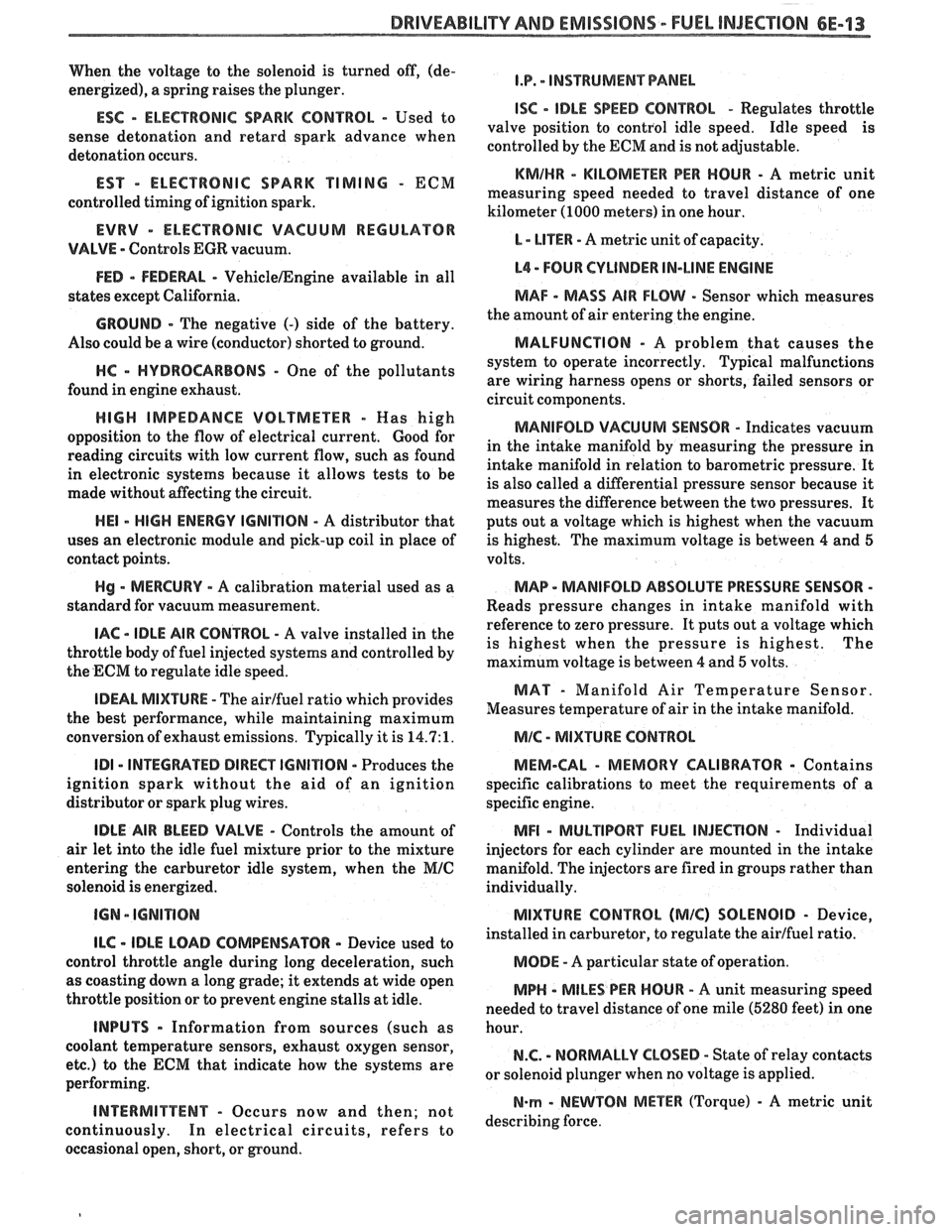
DRIVEABILIW AND EMISSIONS - FUEL INJECTION 6E-13
When the voltage to the solenoid is turned off, (de-
energized), a spring raises the plunger.
ESC - ELECTRONIC SPARK CONTROL - Used to
sense detonation and retard spark advance when
detonation occurs.
EST - ELECTRONIC SPARK TIMING - ECM
controlled timing of ignition spark.
EVRV - ELECTRONIC VACUUM REGULAWR
VALVE - Controls EGR vacuum.
FED - FEDEWL - VehicleIEngine available in all
states except California.
GROUND - The negative (-) side of the battery.
Also could be a wire (conductor) shorted to ground.
HC - HYDROCARBONS - One of the pollutants
found in engine exhaust.
HIGH IMPEDANCE VOLTMETER - Mas high
opposition to the flow of electrical current.
Good for
reading circuits with low current flow, such as found
in electronic systems because it allows tests to be
made without affecting the circuit.
HE1 - HIGH ENERGY IGNITION - A distributor that
uses an electronic module and pick-up coil in place of
contact points.
Hg - MERCURY - A calibration material used as a
standard for vacuum measurement.
IAC - IDLE AIR CONTROL - A valve installed in the
throttle body of fuel injected systems and controlled by
the ECM to regulate idle speed.
IDEAL MIXWRE - The airlfuel ratio which provides
the best performance, while maintaining maximum
conversion of exhaust emissions. Typically it is
14.7:1.
ID1 - INTEGRATED DIRECT IGNITION - Produces the
ignition spark without the aid of an ignition
distributor or spark plug wires.
IDLE AIR BLEED VALVE - Controls the amount of
air let into the idle fuel mixture prior to the mixture
entering the carburetor idle system, when the
MIC
solenoid is energized.
ILC - IDLE LOAD COMPENSATOR - Device used to
control throttle angle during long deceleration, such
as coasting down a long grade; it extends at wide open
throttle position or to prevent engine stalls at idle.
INPUTS - Information from sources (such as
coolant temperature sensors, exhaust oxygen sensor,
etc.) to the ECM that indicate how the systems are
performing.
INTERMITTENT - Occurs now and then; not
continuously. In electrical circuits, refers to
occasional open, short, or ground.
I.P. - INSTRUMENT PANEL
ISC - IDLE SPEED CONTROL - Regulates throttle
valve position to control idle speed. Idle speed is
controlled by the ECM and is not adjustable.
KMIHR - KILOMEnR PER HOUR - A metric unit
measuring speed needed to travel distance of one
kilometer (1000 meters) in one hour.
L - LITER - A metric unit of capacity.
L4 - FOUR CYLINDER IN-LINE ENGINE
MAF - MASS AIR FLOW - Sensor which measures
the amount of air entering the engine.
MALFUNCTION - A problem that causes the
system to operate incorrectly. Typical malfunctions
are wiring harness opens or shorts, failed sensors or
circuit components.
MANIFOLD VACUUM SENSOR - Indicates vacuum
in the intake manifold by measuring the pressure in
intake manifold in relation to barometric pressure. It
is also called a differential pressure sensor because
it
measures the difference between the two pressures. It
puts out a voltage which is highest when the vacuum
is highest. The maximum voltage is between 4 and 5
volts.
MAP - MANIFOLD ABSOLUTE PRESSURE SENSOR -
Reads pressure changes in intake manifold with
reference to zero pressure. It puts out a voltage which
is highest when the pressure is highest. The
maximum voltage is between
4 and 5 volts.
MAT - Manifold Air Temperature Sensor.
Measures temperature of air in the intake manifold.
MIC - MIXTURE CONTROL
MEM-CAL
- MEMORY CALIBRATOR - Contains
specific calibrations to meet the requirements of a
specific engine.
MFI - MULTlPORT FUEL INJECnON - Individual
injectors for each cylinder are mounted in the intake
manifold. The injectors are fired in groups rather than
individually.
MIXTURE CONTROL (MIC) SOLENOID - Device,
installed in carburetor, to regulate the airlfuel ratio.
MODE - A particular state of operation.
MPH - MILES PER HOUR - A unit measuring speed
needed to travel distance of one mile (5280 feet) in one
hour.
N.C. - NORMALLY CLOSED - State of relay contacts
or solenoid plunger when no voltage is applied.
N-rn - NEWTON METER (Torque) - A metric unit
describing force.
Page 975 of 1825
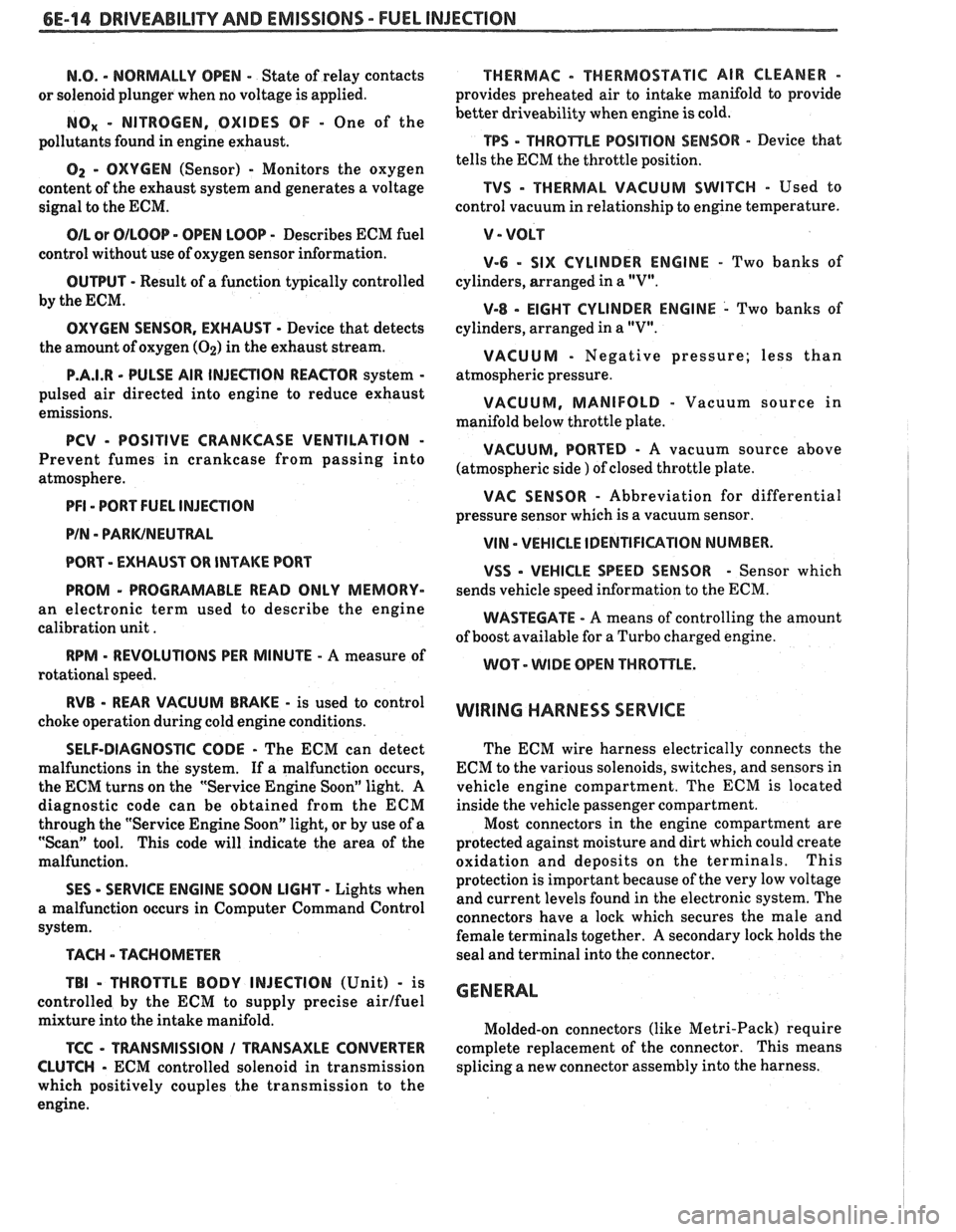
6E-14 DRIVEABILITY AND EMISSIONS - FUEL INJECTION
N.O. - NORMALLY OPEN - State of relay contacts
or solenoid plunger when no voltage
is applied.
NOx - NITROGEN, OXIDES OF - One of the
pollutants found in engine exhaust.
O2 - OXYGEN (Sensor) - Monitors the oxygen
content of the exhaust system and generates a voltage
signal to the ECM.
OIL or OILOOP - OPEN LOOP - Describes ECM fuel
control without use of oxygen sensor information.
OUTPUT - Result of a function typically controlled
by the ECM.
OXYGEN SENSOR. EXHAUST - Device that detects
the amount of oxygen
(02) in the exhaust stream.
P.A.1.R - PULSE AIR INJECTION REACTOR system -
pulsed air directed into engine to reduce exhaust
emissions.
PCV - POSITIVE CRANKCASE VENTILATION -
Prevent fumes in crankcase from passing into
atmosphere.
PFI - PORT FUEL INJECTION
PIN
- PARWNEUTWL
PORT - EXHAUST OR INTAKE PORT
PROM
- PROGRAMABLE READ ONLY MEMORY-
an electronic term used to describe the engine
calibration unit
.
RPM - REVOLUTIONS PER MINUTE - A measure of
rotational speed.
RVB - REAR VACUUM BMKE - is used to control
choke operation during cold engine conditions.
SELF-DIAGNOSTIC CODE - The ECM can detect
malfunctions in the system.
If a malfunction occurs,
the ECM turns on the "Service Engine Soon" light.
A
diagnostic code can be obtained from the ECM
through the "Service Engine Soon" light, or by use of a
"Scan" tool. This code will indicate the area of the
malfunction.
SES - SERVICE ENGINE SOON LIGHT - Lights when
a malfunction occurs in Computer Command Control
system.
TACH - TACHOMETER
TBI
- THROTTLE BODY INJECTION (Unit) - is
controlled by the ECM to supply precise airlfuel
mixture into the intake manifold.
TCC - TWNSMISSION I TRANSAXLE CONVERTER
CLUTCH
- ECM controlled solenoid in transmission
which positively couples the transmission to the
engine.
THERMAC - THERMOSTATIC AIR CLEANER -
provides preheated air to intake manifold to provide
better driveability when engine
is cold.
TPS - THROnLE POSITION SENSOR - Device that
tells the ECM the throttle position.
TVS - THERMAL VACUUM SWITCH - Used to
control vacuum in relationship to engine temperature.
V - VOLT
V-6 - SIX CYLINDER ENGINE - Two banks of
cylinders, arranged in a
"V".
V-8 - EIGHT CYLINDER ENGINE - Two banks of
cylinders, arranged in a
"V".
VACUUM - Negative pressure; less than
atmospheric pressure.
VACUUM, MANIFOLD - Vacuum source in
manifold below throttle plate.
VACUUM, PORTED - A vacuum source above I (atmospheric side ) of closed throttle plate. , I
WAC SENSOR - Abbreviation for differential
pressure sensor which is a
vacuum sensor.
VIN - VEHICLE IDENTIFIUTION NUMBER. 1
VSS - VEHICLE SPEED SENSOR - Sensor which
sends vehicle speed information to the ECM.
WASTECATE - A means of controlling the amount
of boost available for a Turbo charged engine.
WOT- WIDE OPEN THROPTLE. I
WIRING HARNESS SERVICE I
The ECM wire harness electrically connects the
ECM to the various solenoids, switches, and sensors in
vehicle engine compartment. The ECM is located
inside the vehicle passenger compartment.
Most connectors in the engine compartment are
protected against moisture and dirt which could create
oxidation and deposits on the terminals. This
protection is important because of the very low voltage
and current levels found in the electronic system. The
connectors have a lock which secures the male and
female terminals together. A secondary lock holds the
seal and terminal into the connector.
GENERAL
Molded-on connectors (like Metri-Pack) require
complete replacement of the connector. This means
splicing a new connector assembly into the harness.
Page 976 of 1825
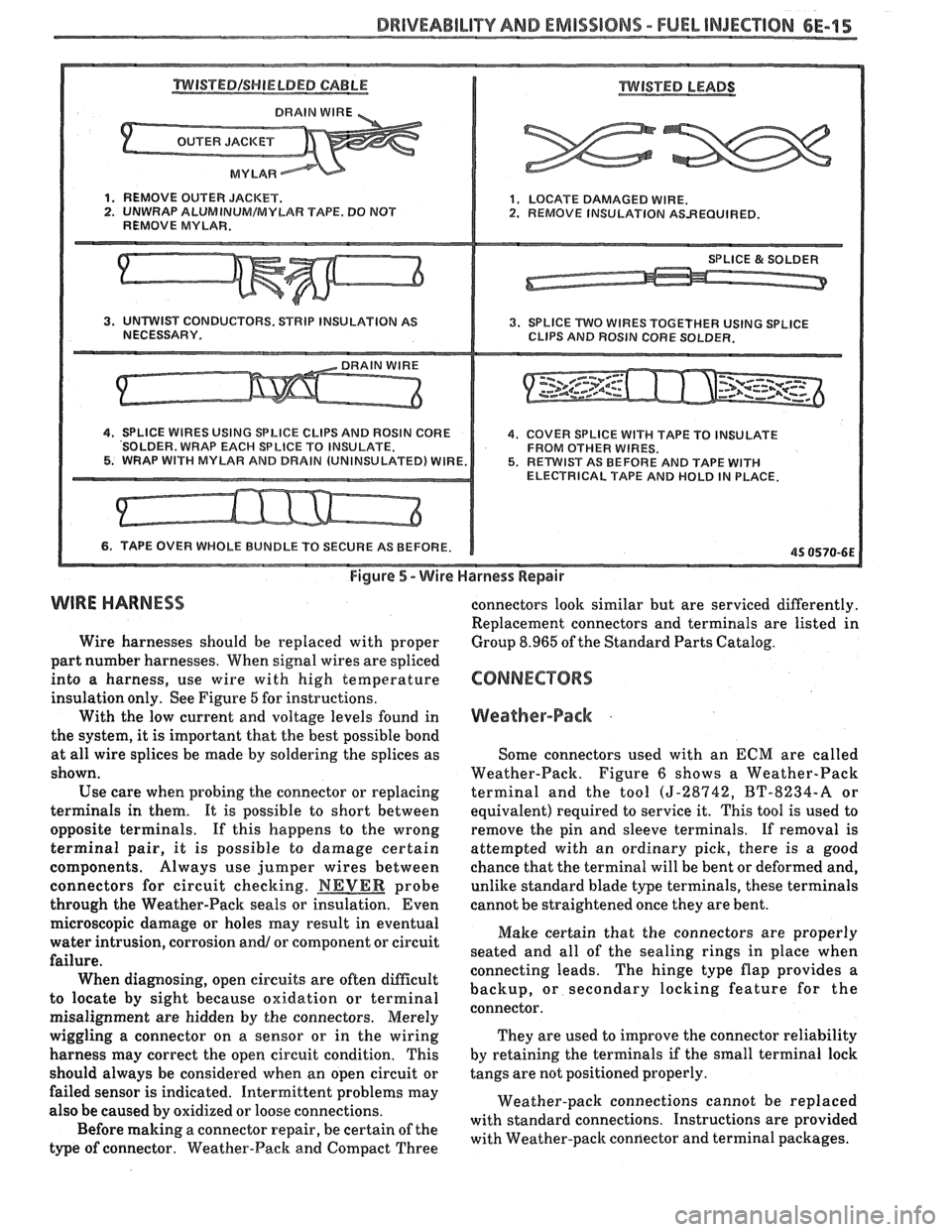
DRIVEABILITY AND EMISSIONS - FUEL INJECIION 6E-15
1. REMOVE OUTER JACKET. 2. UNWRAP ALUMINYM/MYbAR TAPE. DO NOT
REMOVE MYLAR. 4. LOCATE DAMAGED WIRE. 2. REMOVE INSULATION ASBEOUIRED.
3. UNTWIST CONDUCTORS. STRIP INSULATION AS 3. SPLICE TWO WIRES TOGETHER USING SPLICE
NECESSARY. CLIPS AND ROSIN CORE SOLDER.
4. COVER SPLICE WlTH TAPE TO INSULATE
FROM OTHER WIRES.
5. RETWIST AS BEFORE AND TAPE WITH ELECTRICAL TAPE AND HOLD IN PLACE.
6. TAPE OVER WHOLE BUNDLE TO SECURE AS BEFORE.
Figure 5 - Wire Harness Repair
WIRE HARNESS
Wire harnesses should be replaced with proper
part number harnesses. When signal wires are spliced
into a harness, use wire with high temperature
insulation only. See Figure
6 for instructions.
With the low current and voltage levels found in
the system, it
is important that the best possible bond
at all wire splices be
made by soldering the splices as
shown.
Use care when probing the connector or replacing
terminals in them. It is possible to short between
opposite terminals. If this happens to the wrong
terminal pair, it is possible
to damage certain
components. Always use jumper wires between
connectors for circuit checking.
NEVER probe
through the Weather-Pack seals or insulation. Even connectors
look similar but are serviced differently.
Replacement connectors and terminals are listed in
Group 8.965 of the Standard Parts Catalog.
Weather-Pack .
Some connectors used with an ECM are called
Weather-Pack. Figure
6 shows a Weather-Pack
terminal and the tool
(5-28942, BT-8234-A or
equivalent) required to service it. This tool is used to
remove the pin and sleeve terminals. If removal is
attempted with an ordinary pick, there is a good
chance that the terminal will be bent or deformed and,
unlike standard blade type terminals, these terminals
cannot be straightened once they are bent.
microscopic damage or holes may result in eventual
Make certain that the connectors are properly
water intrusion,
corr~sion an& or component or circuit
seated and all of the sealing rings in place when
failure. connecting leads. The hinge type flap provides a
When diagnosing, open circuits are often
difficult backup, or secondary locking feature for the
to locate by sight because oxidation or terminal
connector.
misalignment are hidden by the connectors. Merely
wiggling a connector on a sensor or in the wiring They
are used to improve the connector reliability
harness may correct the open circuit condition. This by
retaining the terminals
if the small terminal lock
should always be considered when an open circuit or tangs are not
positioned properly.
failed sensor is indicated. Intermittent problems may
Weather-pack connections cannot be replaced
also be caused by oxidized or loose connections.
with standard connections. Instructions are provided
Before making a connector repair, be certain of the
with Weather-pack connector and terminal packages.
type
of connector. Weather-Pack and Compact Three
Page 979 of 1825
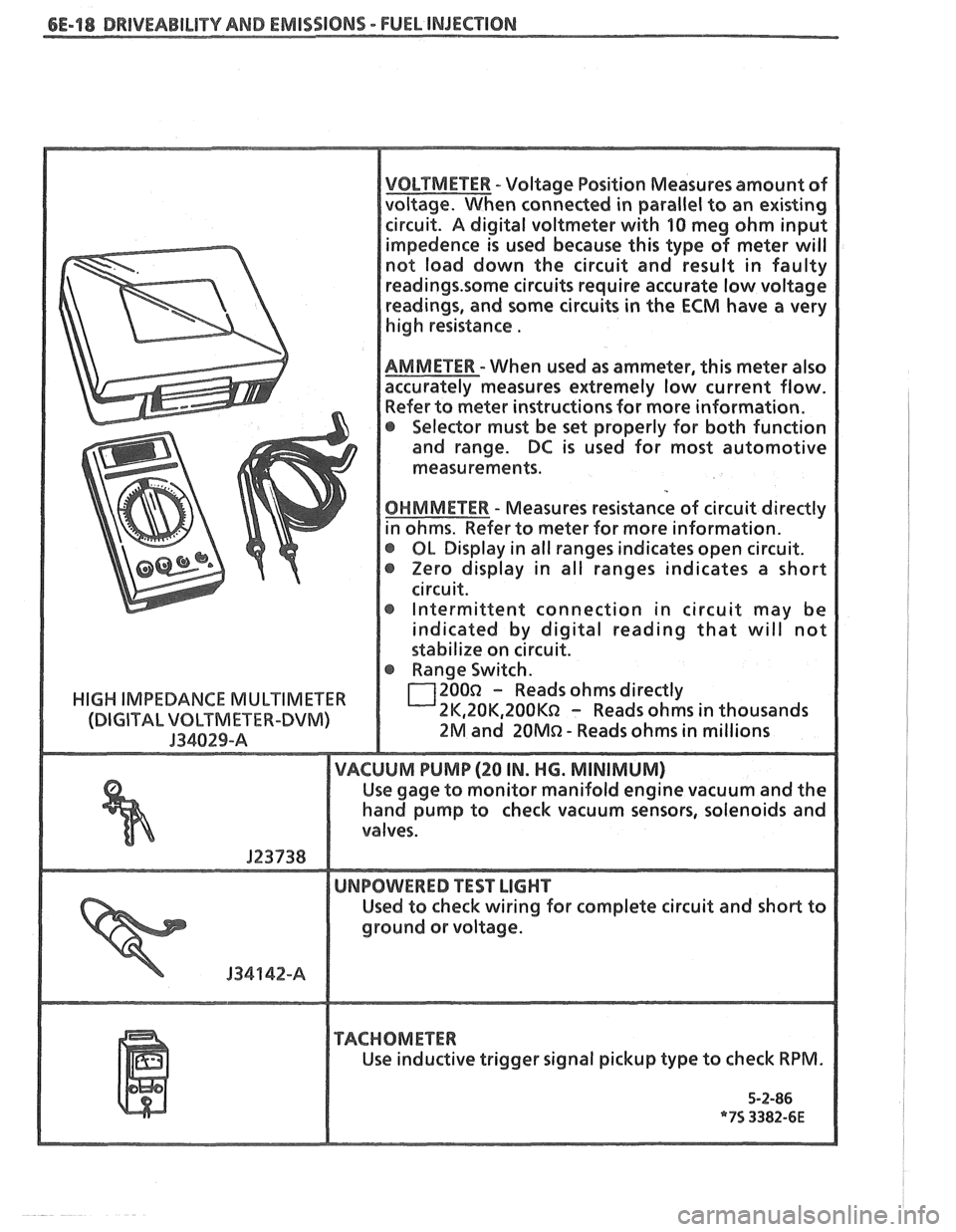
6E-18 DRIVEABILITY AND EMISSIONS - FUEL INJECTION
VOLTMETER - Voltage Position Measures amount of
voltage. When connected in parallel to an existing
circuit.
A digital voltmeter with 90 meg ohm input
impedence
is used because this type of meter will
not load down the circuit and result in faulty
AMMETER -When used as ammeter, this meter also
accurately measures extremely low current flow.
Refer to
meter instructions for more information.
Selector
must be set properly for both function
and range.
DC is used
for most automotive
measu rements.
OHMMETER - Measures resistance of circuit directly
in ohms. Refer to meter for more information.
@ Ob Display in all ranges indicates open circuit.
Zero display in all ranges indicates
a short
@ Intermittent connection in circuit may be
indicated by digital reading that will not
stabilize on circuit.
Range Switch.
HIGH IMPEDANCE MULTIMETER ZOOn - Reads ohms directly
2KfZOKfZ00KR - Reads ohms in thousands
ZM and ZOMn - Reads ohms in millions
Used to check wiring for complete circuit and short to
ground or voltage.
"FACHOMETER
Use inductive trigger signal pickup type to check RPM.
Page 981 of 1825
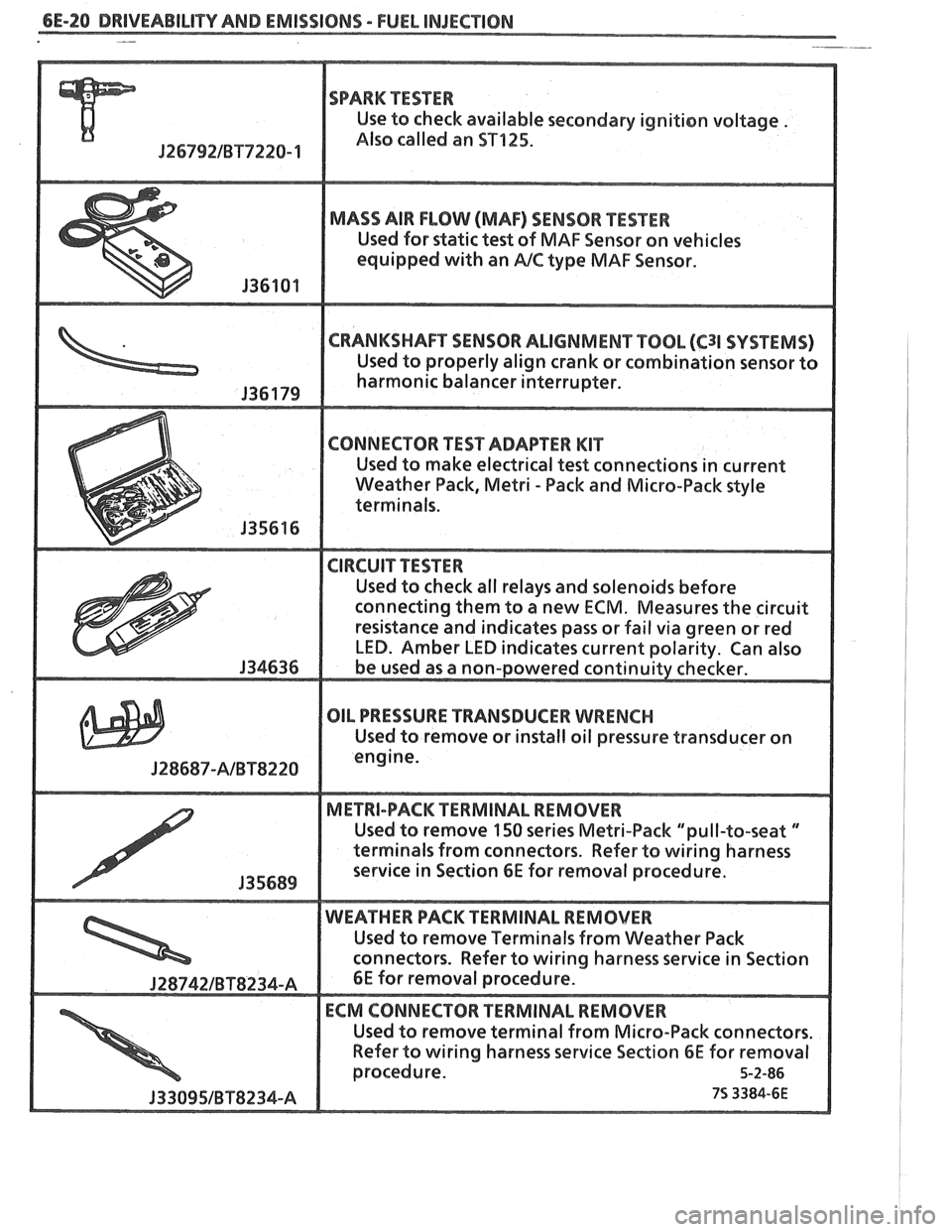
6E-20 DRIVEABILITY AND EMISSIONS - FUEL INJECnION -
SPARK TESTER
Use to check available secondary ignition voltage .
Jf 6792lBT7228- 1 Also called an ST125.
MADS AIR FLOW (MAF) SENSOR PESTER
Used for static test of MAF Sensor on vehicles
equipped
with an PJC type MAF Sensor.
CRANKSHAFT SENSOR ALIGNMENT TOOL (C31 SVSf EMS)
Used "t properly align crank or combination sensor to
harmonic balancer interrupter.
connecting them to a new
ECM. Measures the circuit
OIL PRESSURE TRANSDUCER WRENCH
Used to remove or install oil pressure transducer on
J28687-AlBTS228
Used to remove 150 series Metri-Pack "pull-to-seat "
terminals from connectors. Refer to wiring harness
Used to remove Terminals
from Weather Pack
Refer
to wiring harness service Section 6E for removal